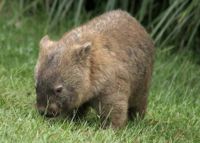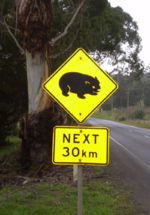Wombat
 From Conservapedia
From Conservapedia | Wombat | |
|---|---|

| |
| Scientific classification | |
| Kingdom Information | |
| Kingdom | Animalia |
| Phylum Information | |
| Phylum | Chordata |
| Class Information | |
| Class | Mammalia |
| Infra-class | Marsupialia |
| Order Information | |
| Order | Diprotodontia |
| Sub-order | Vombatiformes |
| Family Information | |
| Family | Vombatidae |
| Genus Information | |
| Genus | Vombatus |
| Species Information | |
| Species | ursinus |
| Population statistics | |
Wombats are stocky, tailless, ursiform marsupials of the Linnaean taxonomic family Vombatidae. They are nocturnal, walk on four short legs, like to burrow, and are herbivorous.
The common wombat (Vombatus ursinus) reaches about three feet in length and produces distinctive cubical scat.[1] There are also two or three (depending on classification) rare species of hairy-nosed wombats of the genus Lasiorhinus.[2]
One of the distinctive features of wombats is that their pouch opens towards the rear of the animal, like the koala, marsupial mole, and the now-considered-extinct thylacine (tasmanian tiger), but unlike most other marsupials.[3] This may be to avoid the problem of the pouch filling with dirt whilst the animal is burrowing.
Contents
- 1 Origins
- 1.1 Creationary hypothesis
- 1.2 Evolutionary hypothesis
- 2 References
Origins[edit]

Creationary hypothesis[edit]
According to creationists, representatives of the separately created wombat archaebaramin were among those animals that migrated from the Middle East to Australia as part of the Post-Diluvian Diasporas. There is debate whether this migration happened over land[4]—as Australia was still for a time almost connected to Europe by land bridges similar to the one that connected Asia to America[5]—or if they rafted on mats of vegetation torn up by the receding flood waters.[4] Creationists suggest that the rear-opening pouch provides strong evidence for the wombat's special creation.[6]
Evolutionary hypothesis[edit]
Modern wombats belong to the order Diprotodontia (meaning two front teeth). It is thought that the common ancestors of wombats and kangaroos lived about 55-65 million years ago and that wombats are closely related to the koala.[1] This hypothesis is supported by mitochondrial genetic evidence as well as fossil evidence.[7]
References[edit]
- ↑ 1.0 1.1 Review: The Wombat: Common Wombats in Australia by Barbara Triggs
- ↑ Wombat Information Center: Hairy Nosed Wombat
- ↑ http://www.parkweb.vic.gov.au/education/factfiles/03.htm
- ↑ 4.0 4.1 "How did animals get from the Ark to isolated places, such as Australia?", ChristianAnswers.net.
- ↑ Batten, Don, et. al., 207, The Creation Answers Book, Chapter 17
- ↑ "Watches and Wombats", by Ken Ham, Institute for Creation Research
- ↑ Janke A et al. "Phylogenetic analysis of 18S rRNA and the mitochondrial genomes of the wombat, Vombatus ursinus, and the spiny anteater, Tachyglossus aculeatus: increased support for the Marsupionta hypothesis." (2002) Journal of molecular evolution 54:71-80.
Categories: [Marsupials] [Australia]
↧ Download as ZWI file | Last modified: 02/16/2023 01:25:40 | 44 views
☰ Source: https://www.conservapedia.com/Wombat | License: CC BY-SA 3.0
 ZWI signed:
ZWI signed: KSF
KSF